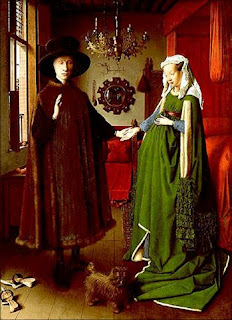Early Renaissance
1. Giotto, ‘Crucifixion’, Scrovegni (Arena) Chapel, Padua, 1305, Fresco
- More realistic, more 3 dimensional
- Early form of perspective : Giotto used atmosheric perspective in this painting.
- This painting was revolutionary at that time since most artists were still sticking with Byzantine Style
- no more gold used.
*Atmospheric Perspective : A method of showing distance by variating colour and clarity.
Renaissance
Renaissance means 're-birth'
All the ancient knowledge that were brought back from other countries during the Crusades, re-inspired people, leading them to the age of Renaissance.
2. Raphael, ‘School of Athens’, Vatican, Rome, 1509-11, Fresco
- Classical Style
-No religious elements or imagery
- Raphael himself in the painting shows role of art at that time.
-Linear perspective
* Humanism :
-After the outbreak of Black Plague
-Interest in humanity
-A worldview focused on human beings
-Interest in life on earth. but this doesn't mean that religion was ignored.
-Extreme Detail
-SIGNED : shows importance and confidence of the artist. Signing on an art piece was very revolutionary at that time.
-not the heroic nudity : shown as a boy
-the Di Medici family was involved - patrons of art
Differences between Northern Renaissance and Southern Renaissance
Northern Renaissance :
-Northern Europe
-Naturalism
-Vivid colour (Jewel colour)
-Incredible detail achieved through the use of oil ,
-Naturalism
-Vivid colour (Jewel colour)
-Incredible detail achieved through the use of oil ,
van Eyck, ‘Arnolfini Wedding Portrait’, 1434, Oil on wood panel
-candle means presence of god
-there is a mirror and 10 miniture medalions around it. Reflection of the witnesses can be seen in the mirror, and each medalion have different painting on it. : Extreme detail
-the lady is not pregnant
Southern Renaissance :
-Italy
-Idealism
-Idealism
Leonardo Da Vinci, “Mona Lisa”, 1503, Louvre Museum
-No jewerlery
-Background gives mysterious feeling
-Chiarosicuro : a tecnique used by Leonardo Da Vinci
-
The Black Plague: resulted in social mobility, emergence of middle class, shift to a more secular (separate from religion) views, emergence of humanism, etc.
The Crusades: contact with other cultures, exposure to lost classical texts, exposure to advanced learning systems (universities), etc
Byzantine Art : artistic products of the Byzantine Empire from about the 4th century until the Fall of Constantinople in 1453.
High Renaissance : The High Renaissance means the culmination of the art of the Italian Renaissance generally toward the end of the 15th c. and early part of the 16th century
Humanism: an interest in humanity, your life on earth, interests apart from religion, a worldview that focused on human beings, an education that perfected individuals through the study of past models of civic and person virtue,, personal effort and responsibility
The Crusades: contact with other cultures, exposure to lost classical texts, exposure to advanced learning systems (universities), etc
Byzantine Art : artistic products of the Byzantine Empire from about the 4th century until the Fall of Constantinople in 1453.
High Renaissance : The High Renaissance means the culmination of the art of the Italian Renaissance generally toward the end of the 15th c. and early part of the 16th century
Humanism: an interest in humanity, your life on earth, interests apart from religion, a worldview that focused on human beings, an education that perfected individuals through the study of past models of civic and person virtue,, personal effort and responsibility










